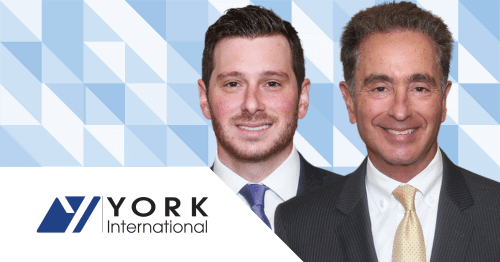
May 20, 2024
Richard Harmon
Founded in 1985 by Jim Krantz, his father, and a handful of insurance industry veterans, York International began as a niche, independent brokerage serving New York City’s real estate community. It flourished into a regional powerhouse, serving a range of corporate clients across the East Coast and beyond.
High-quality standards and a commitment to professional development fueled York’s success. This focus on human capital helped cement the firm’s reputation as a perennial "Best Practices Agency." After 30 years of sustained growth, York’s leadership sought to cement its culture further and secure the firm’s future. They explored an employee stock ownership plan.
Building a Business Succession Strategy
By 2016, York’s two primary shareholders were considering retirement. Although neither envisioned an immediate departure, both recognized the importance of a stable transition.
The stakes were especially high for Jim Krantz. His son Andrew had ascended to a leadership role. Andrew and other members of the next-generation leadership team aspired to grow and own the business, but they lacked the financial resources to buy out Jim and York’s other founders. Their search for an alternative strategy led them to employee stock ownership plans.
"We first heard about ESOPs as a way for shareholders of private companies to partially divest without exiting their firms—that concept resonated with us," recalls Andrew Krantz. "In our research, we looked to other top insurance firms as inspiration and discovered many of them were employee-owned. We knew there was magic there."
Employee ownership offered continued independence, cultural advantages, and a tax-efficient mechanism to transfer equity to the broader team. York’s founders would receive fair market value for their stock as their employees earned shares at no personal cost. Most importantly, the company could structure an ESOP transition in stages, enabling Jim and his partners to retain upside, maximize tax benefits, and consider future M&A opportunities.
Orchestrating a Partial ESOP Sale
Before building their employee stock ownership plan, the team at York hit the books. They familiarized themselves with the nuances of leveraged ESOPs and appointed internal champions to help steward the transaction process. "There are a lot of moving parts, and there really has to be someone with the brains and the bandwidth to engage with it," notes Jim Krantz.
Once the firm’s leadership had a solid grasp of the pros and cons of employee ownership, they engaged CSG Partners to determine ESOP feasibility and build their plan. The process yielded a partial sale financed using a combination of third-party debt and seller paper.
York’s plan was designed to maximize both future flexibility and tax efficiency. The latter was achieved by converting the company from an S corporation to a C corporation at the time the transaction closed. Doing so enabled Jim and other selling shareholders to defer capital gains taxes on their proceeds. The firm also received income tax breaks equivalent to the sale amount.
This initial transaction also offered York the latitude to sell additional equity to the employee trust and potentially revert to an S corporation after five tax years. The latter would result in the firm receiving additional ESOP-specific tax incentives. But when York formally unveiled its ESOP in 2017, its leadership was singularly focused on one thing: implementing the plan.
Embracing Employee Ownership
York’s ESOP formation was widely celebrated by staff and industry peers. But once the initial euphoria subsided, the firm quickly turned its attention to plan adoption. Company-wide education was compulsory. Communications conveying the plan mechanics and York’s employee-ownership goals were consistent.
This outreach strategy reflected years of scholarly research. The performance of employee-owned companies is often correlated with plan adoption.
Participants who understand the potential rewards and limitations of their ESOP benefit are generally more inclined to go the extra mile for their teammates and for their clients. This ownership mentality can drive business results and, ultimately, financial gains for employee owners.
Creating Broad-Based Wealth
As hoped, York’s internal investment paid off. "The ESOP turbocharged our business, accelerated our growth, and strengthened the community," says Andrew. "We were all rowing in the same direction, and all we had to do was show up every day, be good people, and do good work."
By 2021, York had already taken steps towards an ESOP expansion when it was approached by a national financial services firm with ambitious growth plans. Although York’s leadership wasn’t actively soliciting acquisition offers, it was always willing to consider opportunities. What the insurance brokerage received was an overwhelming merger offer.
York’s sale to IMA Financial Group was believed to be the largest US acquisition of an employee-owned company in 2022. It represented a significant liquidity event not only for Jim Krantz and other founding shareholders but also for York’s ESOP participants. Nearly 40 employee owners became millionaires.
Andrew describes closing day as "the fulfillment of an across-the-board financial win. It was beyond powerful and incredible." It was the culmination of a transformative and life-changing ESOP journey for the entire York team.